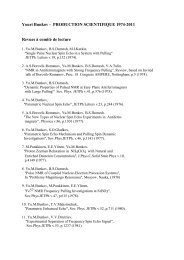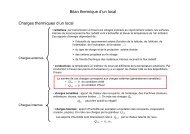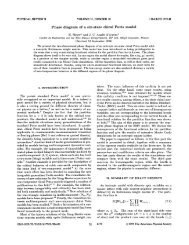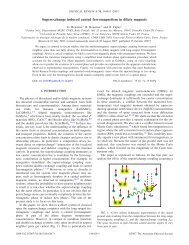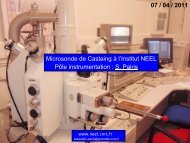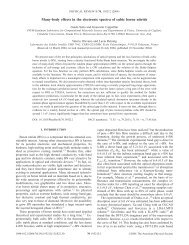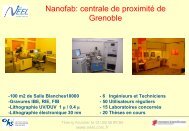Activity Report 2010 - CNRS
Activity Report 2010 - CNRS
Activity Report 2010 - CNRS
You also want an ePaper? Increase the reach of your titles
YUMPU automatically turns print PDFs into web optimized ePapers that Google loves.
OVERVIEW<br />
Tetiana AKSENOVA - A leading expert<br />
involved in the unique world class<br />
program CLINATEC ® .<br />
Previously engineerresearcher<br />
at INSERM,<br />
U318 CHU Grenoble<br />
(from 2002 to 2007),<br />
Tetiana AKSENOVA, 53,<br />
came back to Grenoble<br />
thanks to a full time<br />
Chair of Excellence<br />
granted through the<br />
Nanosciences Foundation’s 2008 Call.<br />
On leave from Ukrainian Academy of<br />
Sciences, and presently at Léti, Tetiana is<br />
also the co-founder of PNN-Soft. Her<br />
group leader proposed CEA to hire<br />
Tetiana full time at the end of the<br />
Nanosciences Foundation’s support.<br />
The procedure of adaptive<br />
calibration is aimed to the fasten BCI<br />
system installation and recalibration. In<br />
<strong>2010</strong> the principle solution for the<br />
adaptive BCI calibration system was<br />
proposed, based on the innovative<br />
recursive algorithm.<br />
There is a constant effort on the<br />
optimization of algorithms. To move<br />
toward multiple degrees of freedom in<br />
humans and in order to improve the BCI<br />
performance the algorithm of fast signal<br />
decomposition were proposed (patent in<br />
preparation).<br />
Leading expert in the field of machine<br />
learning and real time signal processing,<br />
Tetiana AKSENOVA invented several<br />
innovative approaches for signal<br />
processing, classification and modelling<br />
that can be used for Brain Computer<br />
Interface design. She made a crucial<br />
improvement in the theoretical study and<br />
practical application of GMDH-type<br />
(Group Method of Data Handling) neural<br />
networks, effective self learning approach<br />
for the regression analysis which is used<br />
as a basis for self learning procedure of<br />
Brain Computer Interface (BCI).<br />
Her activity at CLINATEC ® overlaps with<br />
the project Neurolink which aims at<br />
improving the stability and the quality of<br />
electrical interface between neural<br />
network and nanostructured electrodes<br />
using multiwall carbon nanotubes.<br />
The challenge of the project is to design<br />
fully autonomous self-paced systems for<br />
continuous long term monitoring of<br />
neuronal activity functioning in natural<br />
noisy environment. Major achievements<br />
have already been obtained:<br />
Functional self-paced BCI with<br />
one degree of freedom in freely moving<br />
animals (rodents) was achieved during<br />
the first year of the project. It includes<br />
the development of basic methods and<br />
algorithms (offline and online), software<br />
implementation on MatLab and their<br />
incorporation into the BCI platform. (A<br />
patent has been submitted in <strong>2010</strong>.)<br />
The second year concerned<br />
preclinical studies in animals. Self paced<br />
1D BCI system demonstrated perfect<br />
robustness and high quality of prediction:<br />
the 8 month- long experiment with one<br />
animal validated the robustness of<br />
algorithms. The experiments to study of<br />
Subject-to-Subject variability with<br />
several animals are in progress.<br />
6



